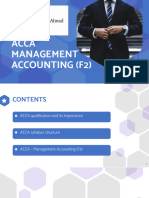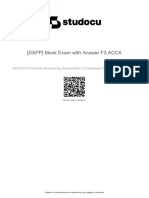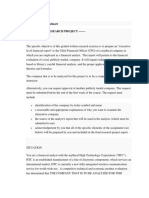Acca F2
Acca F2
Uploaded by
Diana AldanovaCopyright:
Available Formats
Acca F2
Acca F2
Uploaded by
Diana AldanovaOriginal Description:
Original Title
Copyright
Available Formats
Share this document
Did you find this document useful?
Is this content inappropriate?
Copyright:
Available Formats
Acca F2
Acca F2
Uploaded by
Diana AldanovaCopyright:
Available Formats
Examiners report
F2/FMA Management Accounting December 2011
General Comments This was the first examination under the new syllabus. This syllabus brings together the old CAT T7 Planning control and performance management paper (now the FIA FMA paper) and the old ACCA F2 Management accounting paper, into one common syllabus and examination. This involved the introduction of some new topics to FMA and F2 students and a change in examination format. The two hour paper contained 50 multiple choice questions each worth 2 marks. The mix of questions across syllabus heads was exactly in line with the pilot paper. The general performance of candidates was a little disappointing. This is only partially explained by the introduction of new topics; only 40% of the poorly attempted questions related to new topic areas. The remaining 60% of poorly attempted questions related to areas common to both of the old syllabi. The change in examination format was most significant for the FIA FMA candidates and overall they performed worse than their F2 counterparts. Most, but not all, of the poorly attempted questions were calculation based. The following questions taken from the December 2011 examination are ones where the performance of candidates was weak in each case less than 30% of the candidates selected the correct answer. Each of these questions carried 2 marks and each related to a mainstream topic in the Study Guide. Sample Questions for Discussion Example 1. The Cost $ 4,000 7,000 10,000 9,500 following shows the total overhead costs for given levels of a companys total output. Output units 1,000 2,000 3,000 4,000
A step up in fixed costs of $500 occurs at an output level of 3,500 units. What would be the variable overhead cost per unit (to the nearest $0.01) using the high low technique? A $167 per unit B $183 per unit C $275 per unit D $300 per unit This question relates to study guide reference A 3. h). The high low technique estimates variable cost per unit by looking at the change in costs between the highest and lowest levels of output. The correct answer is A. This can be calculated by finding the change in cost between the highest and lowest output levels not explained by the step in fixed costs ($9,500 -$4,000 -$500 = $5,000) , and dividing by the change in output between the highest and lowest output levels. ($5,000 / (4,000 units 1,000 units) = $1.67 per unit. Many candidates incorrectly based their calculations on the change in costs between the highest and lowest levels of cost, and hence selected option D (($10,000 - $4,000)/ (3,000 units 1,000 units) or C (($10,000 $4,000 - $500)/ (3,000 units 1,000 units). This mistake suggests some confusion between the independent variable, output, and the dependent variable, cost.
Examiners report F2/FMA December 2011
Example 2. A company calculates the following under a standard absorption costing system. (i) The sales volume margin variance (ii) The total fixed overhead variance (iii) The total variable overhead variance If a company changed to a standard marginal costing system, which variances could change in value? A (i) only B (ii) only C (i) and (ii) only D (i), (ii) and (iii) This question relates to study guide heading D 1 b). The correct answer is C. In a standard absorption costing system the sales volume margin variance is based upon profit per unit, whereas under a marginal costing system it is based upon contribution per unit. In a standard absorption costing system the total fixed overhead variance includes expenditure and volume variances. Under marginal costing only the expenditure variance is included. Variable cost variances are the same under both systems. Only 15% of candidates selected the correct alternative. The most frequent answers were A (37% of candidates), and B (30 %of candidates). This is essentially a knowledge based question, and the poor results suggest that candidates need to do more work in this area.
Example 3. A company has current assets of $18m, including inventory of $05m, and current liabilities of $10m. What would be the effect on the value of the current and acid test ratios if the company bought more raw material inventory on three months credit? Current ratio A B C D Increase Decrease Increase Decrease Acid test Increase Increase Decrease Decrease
This question relates to study guide reference E 2 a). The correct answer is D, both ratios will decrease. The opening current ratio (current assets /current liabilities) is $1.8m/$1.0m = 1.8, and the opening acid test (current assets less stock/ current liabilities) is $1.3m/$1.0m =1.3. Purchasing (say) $1.0m of inventory on short term credit will decrease the current ratio to ($1.8m + $1m)/ ($1.0m+ $1.0m) = 1.4. The acid test would also decrease to $1.8m/ ($1.0m+ $1.0m) = 0.9. Only 23% of candidates selected this alternative. The most frequently chosen alternative was C (41% 0f candidates). On this type of question if the answer is not immediately clear candidates should substitute in some simple numbers to test out the effects of a transaction.
Examiners report F2/FMA December 2011
Inevitably examiners reports focus on the more difficult questions that were badly attempted. The exam also contained a number of questions that were very well answered. In the examination candidates should ensure that they attempt the easier questions first to ensure they gain the easy marks. They can then go on to attempt the more difficult or time consuming questions last.
Future candidates are advised to: Study the whole syllabus. Practise as many questions as possible in preparing for the examination. Read questions very carefully in the examination. Attempt all questions in the examination (there are no negative marks for incorrect answers). Try to attempt the easy examination questions first. Not to spend too much time on apparently difficult questions. Read previous Examiners Reports.
Examiners report F2/FMA December 2011
You might also like
- f2 Acca Fma BPP Kit 2021 For StudentDocument187 pagesf2 Acca Fma BPP Kit 2021 For StudentTranh Meow MeowNo ratings yet
- ACCA F2 FormulasDocument1 pageACCA F2 Formulasabstract_art111740% (5)
- F2 - Past PapersDocument298 pagesF2 - Past Papersbilligee73% (11)
- Free CBE ACCA F3 Financial Accounting Mock ExamDocument15 pagesFree CBE ACCA F3 Financial Accounting Mock ExamACCALIVE82% (17)
- Exam Focused Revision Notes May 2009: Strategic Level CimaDocument84 pagesExam Focused Revision Notes May 2009: Strategic Level Cimamk59030100% (2)
- f2 Mock ExameDocument41 pagesf2 Mock ExameZuhaib Iqbal67% (6)
- What Is AATDocument7 pagesWhat Is AATSyed AhmadNo ratings yet
- ACCA F2 SyllabusDocument2 pagesACCA F2 SyllabussairambabailoveyouNo ratings yet
- Acca Supplementary NotesDocument185 pagesAcca Supplementary NotesSuniel JamilNo ratings yet
- ACCA F2 VariancesDocument12 pagesACCA F2 VariancesLiam Bourke50% (2)
- f2 Revesion Notes by AmmarDocument76 pagesf2 Revesion Notes by Ammarammar_acca9681100% (1)
- ACCA F9 Course NotesDocument229 pagesACCA F9 Course NotesNagendra Krishnamurthy100% (1)
- 1695205417introduction To ACCA - Management AccountingDocument31 pages1695205417introduction To ACCA - Management AccountingDhanuja jayamalNo ratings yet
- f1 SQB 15 SampleDocument17 pagesf1 SQB 15 SampleNithyananda PatelNo ratings yet
- F3 Financial Accounting in Revision Kit BPP PDFDocument2 pagesF3 Financial Accounting in Revision Kit BPP PDFKatie33% (3)
- ACCA - F2 Management Accounting CBE Based Mock ExamDocument14 pagesACCA - F2 Management Accounting CBE Based Mock ExamACCALIVE100% (4)
- f2 Acca Lesson6 (Labour)Document10 pagesf2 Acca Lesson6 (Labour)Mikhail Banhan100% (1)
- Sapp Mock Exam With Answer f3 AccaDocument25 pagesSapp Mock Exam With Answer f3 Accateamxsz07No ratings yet
- ACCA F2 December 2015 NotesDocument188 pagesACCA F2 December 2015 NotesOpenTuition.com100% (2)
- LSBF Big Book of ACCA Tips PDFDocument19 pagesLSBF Big Book of ACCA Tips PDFphoebeNo ratings yet
- CIMA SCS - May 2021 - Mock 1 Debrief 3Document1 pageCIMA SCS - May 2021 - Mock 1 Debrief 3Kim P. TranNo ratings yet
- F2 Pre-Exam QuestionsDocument7 pagesF2 Pre-Exam Questionsaddi420100% (1)
- Acca F2Document13 pagesAcca F2Ravi KureemunNo ratings yet
- Acca f2 Management Accountant Topicwise Past PapersDocument44 pagesAcca f2 Management Accountant Topicwise Past PapersIkram Naguib100% (2)
- Mock Exam Walkthrough - LearnSignal CIMADocument4 pagesMock Exam Walkthrough - LearnSignal CIMAKim P. TranNo ratings yet
- ACCA F3 Quiz QuestionDocument5 pagesACCA F3 Quiz QuestionA Muneeb Q100% (1)
- Acca F2 Management Accounting: June2015Document17 pagesAcca F2 Management Accounting: June2015keerthana_giri8772No ratings yet
- ACCA F2 Final MocksDocument43 pagesACCA F2 Final Mocksadnan7985% (13)
- PM BECKER Mock 1 Que.Document14 pagesPM BECKER Mock 1 Que.SHIVAM BARANWALNo ratings yet
- Acca f2 Notes j15Document188 pagesAcca f2 Notes j15opentuitionID100% (2)
- Acca f5Document39 pagesAcca f5iftikharali1100% (4)
- A1238654318 18761 2 2019 Cmaexamsupportpackage201819Document552 pagesA1238654318 18761 2 2019 Cmaexamsupportpackage201819Sahil KumarNo ratings yet
- ACCA F5 Course Notes PDFDocument330 pagesACCA F5 Course Notes PDFAmanda7100% (1)
- Tx-Uk Mock 1Document20 pagesTx-Uk Mock 1Lalan JaiswalNo ratings yet
- Cima f3 Workbook Q & A 2015 PDFDocument139 pagesCima f3 Workbook Q & A 2015 PDFCharleneGentleSchoeman50% (2)
- f3 Interactive Self Study GuideDocument23 pagesf3 Interactive Self Study GuideIskandar BudionoNo ratings yet
- Answers To Mock Exams F1 December 2019Document2 pagesAnswers To Mock Exams F1 December 2019Maubarak BoodhunNo ratings yet
- 2022 - 23 Financial Management (FM) - Mock 1Document13 pages2022 - 23 Financial Management (FM) - Mock 1Mapepa ProudNo ratings yet
- F3 Mocks: Updated 2010-2011 and Onward As Per Kaplan (FTC) Book On F3Document75 pagesF3 Mocks: Updated 2010-2011 and Onward As Per Kaplan (FTC) Book On F3adnan79100% (7)
- ACCA P4 Key Point Notes December 2010Document138 pagesACCA P4 Key Point Notes December 2010ACCAbooks100% (4)
- Practice Assessment 1 6Document22 pagesPractice Assessment 1 6kbassignmentNo ratings yet
- f2 Mock ExamDocument18 pagesf2 Mock Examsumit72923No ratings yet
- Examiner's Report: F2/FMA Management Accounting December 2011Document3 pagesExaminer's Report: F2/FMA Management Accounting December 2011Tumus TonyNo ratings yet
- F2.fma Examreport Jul Dec14Document4 pagesF2.fma Examreport Jul Dec14Syeda ToobaNo ratings yet
- Examiner's Report: F2/FMA Management Accounting For CBE and Paper Exams Covering July To December 2014Document4 pagesExaminer's Report: F2/FMA Management Accounting For CBE and Paper Exams Covering July To December 2014Kamisiro RizeNo ratings yet
- f2 Fma Examreport j15 PDFDocument3 pagesf2 Fma Examreport j15 PDFqeylazatiey93_598514No ratings yet
- Examiner's Report: F2 Management Accounting December 2010Document3 pagesExaminer's Report: F2 Management Accounting December 2010shan_waheedNo ratings yet
- Examiner's Report: Performance Management (PM) June 2019Document8 pagesExaminer's Report: Performance Management (PM) June 2019Bryan EngNo ratings yet
- Examiner's Report: MA2 Managing Costs & Finance December 2012Document4 pagesExaminer's Report: MA2 Managing Costs & Finance December 2012Ahmad Hafid Hanifah100% (1)
- MA1 Exam Report June 2012Document3 pagesMA1 Exam Report June 2012S.L.L.CNo ratings yet
- F5-Examreport-D15 (Deleted)Document4 pagesF5-Examreport-D15 (Deleted)Nausheen Ahmed NobaNo ratings yet
- Examiner's Report: For CBE and Paper Exams Covering July To December 2013Document3 pagesExaminer's Report: For CBE and Paper Exams Covering July To December 2013eiffa batrisyiaNo ratings yet
- Examiner's Report: MA2 Managing Costs & Finances For CBE and Paper Exams Covering January To June 2013Document3 pagesExaminer's Report: MA2 Managing Costs & Finances For CBE and Paper Exams Covering January To June 2013linh nguyễn100% (1)
- Examiner's Report: F5 Performance Management June 2018Document8 pagesExaminer's Report: F5 Performance Management June 2018Minh PhươngNo ratings yet
- Examiner's Report F2/FMA: For CBE and Paper Exams Covering January To June 2016Document5 pagesExaminer's Report F2/FMA: For CBE and Paper Exams Covering January To June 2016Minh NguyễnNo ratings yet
- f2 Fma Examreport j13 PDFDocument3 pagesf2 Fma Examreport j13 PDFSergelen TurkhuuNo ratings yet
- Ma2 Exam ReportDocument3 pagesMa2 Exam ReportAhmad Hafid Hanifah100% (1)
- PM Examiner's Report M20Document8 pagesPM Examiner's Report M20tramng12No ratings yet
- F5 Examiners Report March 18Document8 pagesF5 Examiners Report March 18Izhar MumtazNo ratings yet
- Examiner's Report: F2 Management Accounting June 2011Document3 pagesExaminer's Report: F2 Management Accounting June 2011Aliona DmytrukNo ratings yet
- Ec 1630 Final Study GuideDocument75 pagesEc 1630 Final Study GuideTanit Kane ChearavanontNo ratings yet
- Chattanooga Businessmen Under Investigation For Securities FraudDocument22 pagesChattanooga Businessmen Under Investigation For Securities FraudDan LehrNo ratings yet
- Explaining Asset Prices: Nobel Prize in Economics 2013: by Dr. Paramita MukherjeeDocument4 pagesExplaining Asset Prices: Nobel Prize in Economics 2013: by Dr. Paramita MukherjeeParomita Adhya MukherjeeNo ratings yet
- Gemstone KenyaDocument12 pagesGemstone KenyajohnmaunduNo ratings yet
- Major Companies Romania 2012 WebDocument228 pagesMajor Companies Romania 2012 WebTREND_7425No ratings yet
- IFRS-10 Selected Opinion by ICAPDocument16 pagesIFRS-10 Selected Opinion by ICAPAbbas AliNo ratings yet
- Public ExpenditureDocument4 pagesPublic ExpenditureadityatnnlsNo ratings yet
- Additional Deferred Tax Examples.2Document3 pagesAdditional Deferred Tax Examples.2milton1986100% (1)
- Terryann Bodden Revised Resume November 2017Document2 pagesTerryann Bodden Revised Resume November 2017api-341396604No ratings yet
- 12 - MWS96KEE127BAS - 1research Project - WalmartDocument7 pages12 - MWS96KEE127BAS - 1research Project - WalmartashibhallauNo ratings yet
- PP05Document73 pagesPP05aahsaaanNo ratings yet
- Bruce Byrd 2013 Tax Return - T13 - For - Records PDFDocument69 pagesBruce Byrd 2013 Tax Return - T13 - For - Records PDFjessica50% (2)
- Providing and Obtaining CreditDocument51 pagesProviding and Obtaining CreditMahmoud AbdullahNo ratings yet
- Insurance IntermediariesDocument9 pagesInsurance IntermediariesarmailgmNo ratings yet
- Today Is Monday, July 22, 2019: Supreme CourtDocument6 pagesToday Is Monday, July 22, 2019: Supreme CourtVanessa GaringoNo ratings yet
- 01-EOI Business Plan Fin Strategy CCDMCDocument11 pages01-EOI Business Plan Fin Strategy CCDMCchakri724No ratings yet
- Ficci Corporate MembersDocument3 pagesFicci Corporate MembersAmresh PathakNo ratings yet
- Inventory ManagementDocument74 pagesInventory ManagementSonia LawsonNo ratings yet
- Chap 6 BKMDocument53 pagesChap 6 BKMShahmir Hamza AhmedNo ratings yet
- Randy Gage - Prosperity GuideDocument26 pagesRandy Gage - Prosperity GuideNicoletaIgnat100% (2)
- Unilever in BrazilDocument4 pagesUnilever in BrazilSarah GhummanNo ratings yet
- Consumer Perception Regarding Life Insurance Policies: A Factor Analytical ApproachDocument10 pagesConsumer Perception Regarding Life Insurance Policies: A Factor Analytical ApproachJoseph SajiNo ratings yet
- Review Sheet For Governmental Accounting Exam 1Document2 pagesReview Sheet For Governmental Accounting Exam 1Jordan BelkeNo ratings yet
- Operational Research Assignment............ (Ca Final Cost and Or)Document87 pagesOperational Research Assignment............ (Ca Final Cost and Or)Pravinn_Mahajan80% (5)
- Secrecy of Bank Deposit Act (RA 1405)Document2 pagesSecrecy of Bank Deposit Act (RA 1405)alvinbfranciscoNo ratings yet
- Star River Electronic LTDDocument1 pageStar River Electronic LTDendiaoNo ratings yet
- A.I.G.'s Lawsuit Against Bank of AmericaDocument193 pagesA.I.G.'s Lawsuit Against Bank of AmericaDealBook100% (2)
- Cemco Holdings Vs National Life InsuranceDocument3 pagesCemco Holdings Vs National Life InsuranceRowena Gallego100% (2)
- Prospectus of New Line Clothings LTD PDFDocument268 pagesProspectus of New Line Clothings LTD PDFEl TahitNo ratings yet
























































































